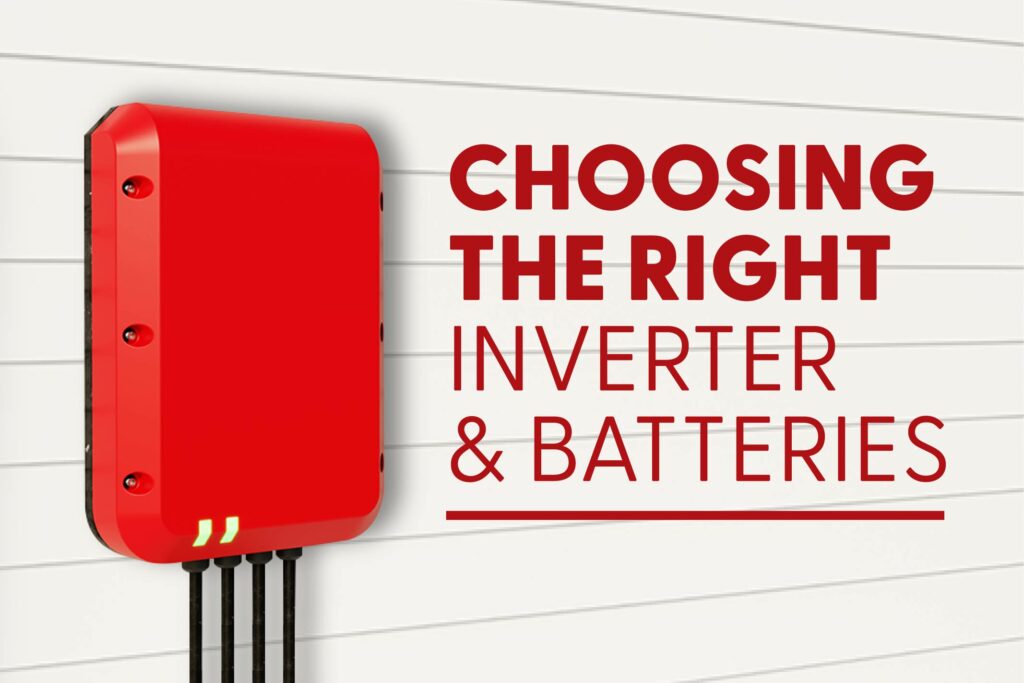Blog
Choosing The Right Inverter & Batteries
Load-shedding is unrelenting, and South Africans continue to look for ways to remedy the hours of having no electricity.
An increasingly popular solution is to invest in an inverter and battery system. An inverter is a backup power-generating device that draws power from a battery. The battery is charged through your household electricity supply when available and stores this power to be used during load-shedding by the inverter, which provides your home with an uninterrupted electricity supply.
The challenge, however, is choosing the right inverter and battery for your needs. There is no one-size-fits-all solution as the needs of every household or office are different.
To help, Orlando Luis, the CEO of BRIGHTS Hardware has provided a simple 3-step guide to choosing the right inverter and battery system to fit your power needs.
Step 1: Identify Your Power Requirements
“Start by making a list of the devices and appliances you want to run during a power outage. Perhaps it is the TV, Wi-Fi, a few lights, and maybe the fridge – for example. Then add up the wattage of all these items to work out your total needs per hour. An average Wi-Fi modem uses 15W, a TV is approximately 150W, a fridge uses 500W and five 10W LED lightbulbs use 50W – this totals about 715W, so a minimum 1000W inverter would be required.”
“Note, that it is not recommended that you run too many large appliances from an inverter system as they draw a large amount of energy.”
Step 2: Pick an inverter
Now, the next step is to buy an inverter with a capacity suitable for your needs.
“The amount of power that the inverter is capable of supplying is known as the inverter capacity. The inverter’s rating must be at least 25% greater than the total amount of power you need to run all your devices and appliances at once. The inverter capacity, which is measured in Volt Ampere or Watts, is directly proportional to the number of devices and appliances that you are looking to power with it. You can find the value of the inverter’s capacity in the product description when you purchase.”
Luis explains that there are four main types of inverters to choose from.
- Off-grid: These have no connection to Eskom, but also no ability to put energy back into the grid.
- On-grid: These inverters are connected to the Eskom grid, and they will also put excess power back into the Eskom grid when available.
- Grid-interactive: These inverters do not have to be connected to the Eskom grid, but can be.
- Hybrid: These inverters combine the characteristics of grid-interactive and on-grid inverters.
“On-grid systems do not need storage/batteries; off-grid systems need sufficient batteries for energy storage, and hybrid systems require a battery storage size that is dependent on your load requirements. In all solutions, focus on meeting your household needs, if you prefer an expensive grid tide system ensure that you obtain a qualified company that will do the application to the council for approval.”
Checking the wiring before you buy
Luis cautions that one of the crucial things to do before picking an inverter is to see if your home wiring is compatible with the inverter you are buying. “Consulting with your technician and determining if your home is compatible with the inverter you are planning to buy is always a good idea.”
Step 3: Get The Correct Battery
“The correct battery is the backbone of an inverter system. Ensure that your inverter batteries’ capacity matches the capacity of your inverter. Note that a battery’s capacity is the electricity it can store, and the inverter capacity is the amount of electricity it can serve at a time,” says Luis, who advises that BRIGHTS recommends either lithium, gel, absorbent glass matt, deep-cycle, and G/P batteries as good choices.
The battery capacity, which is calculated in Ampere hours, can be found based on the backup time needed for all your appliances. There is a simple calculation that will help you pick the perfect battery for your needs:
“Multiply the wattage you need by the time you need it for. For example, if you need to run devices and appliances that total 265W (your calculations) multiplied by 4,5 hours (the amount of time you need it for) you come out with a total of 1192,5Wh – this is your energy needs in Watt hours.”
“If your chosen inverter has, for example, a 5000W, 48V capacity, you then divide your total energy needs (1192.5Wh) by the inverter’s capacity (48V), which gives you a minimum battery capacity of 24.84Ah. BRIGHTS always recommend rounding up to the nearest 100, to be safe – so in this instance, a 100Ah battery would be ideal.”
Below are useful tips on how to take care of your batteries:
- Make sure the inverter battery is installed in a well-ventilated area. This reduces the heating up of the battery thereby maintaining its lifespan.
- Even if there is no power outage, make sure your batteries are still used by discharging them at least once a month.
- Keep your battery away from fire and smoke.
- Ensure proper loading of devices. Do not connect loads greater than what the inverter was designed to carry.
- Disconnect extra load when not in use.
- Use energy-saving devices on the power backup system.
- If a battery is damaged, replace it. Do not combine old and new batteries together in a system. Routine maintenance will help you know about changes to be made with respect to your inverter and battery.
- Allowing the power in the battery to drain completely frequently before recharging damages the inverter battery’s cells. This reduces its lifespan.
- Batteries have a certain amount of charging cycles please request this information from the salesperson before purchasing your battery.
- Always ensure that your system is installed by a qualified installer, who has certification for solar solutions and can provide you with a Certificate of Compliance for installation. An Installer is not needed for a plug-and-play unit however it is wise to get the advice of somebody qualified before making your purchase.
Inverter vs UPS
Luis advises that a UPS is better suited for PCs because an inverter takes one microsecond to fall over to the backup power, and this delay in switching may harm the system. Inverters are better for powering appliances such as fans, lights, TVs, etc.
“An inverter is a great investment to keep your home and office running effectively during power outages. Following this inverter buying guide will help you buy one that satisfies all your power requirements.”









